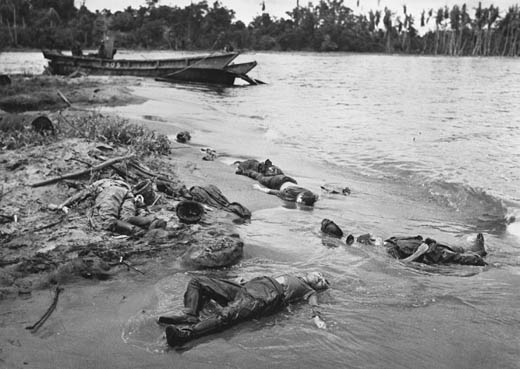Air Operations, Bismarcks
V Bomber Command bombers attack the Gasmata airfield, New Britain.
[Air Operations, CBI
BURMA- 6 11th Medium Bomb Group B-25s attack the airfield at Monywa.
- 75th Fighter Squadron P-40s strafe transportation targets along the Burma Road near Loiwing.
Air Operations, Crete
- To help stem Axis air attacks against Allied convoys bound for Malta, 12 376th Heavy Bomb Group B-24s join 36 RAF light bombers for an attack against Kastelli/Pediada Airdrome, and 11 12th Medium Bomb Group B-25s attack Heraklion Airdrome. The is the 12th Air Force's first combat mission outside of North Africa.
- 2 B-25s are lost over the sea to unknown causes on the return flight.
Air Operations, Europe
BOMBER COMMANDDaylight Ops:
- 12 Bostons and 1 Mosquito are ordered to attack a whaling factory ship at Cherbourg but are recalled.
- 42 Lancasters and Wellingtons lay mines off the Biscay ports.
Air Operations, Mediterranean
- During this month Stukas, FW-190 fighter-bombers and He-111 torpedo planes make frequent sorties against Allies shipping in and around Bône, Bougie and Algiers. 4 ships are sunk; the cruiser Ajax, 1 destroyer and an AA ship are damaged.
- The Allies make their first daylight raid on Crete.
Air Operations, New Guinea
V Bomber Command bombers attack the airfield at Lae and targets of opportunity.
[Air Operations, Solomons
- AirSoPac B-17s, escorted by 339th Fighter Squadron P-38s, attack Japanese destroyer near the Shortland Islands.
- A VMF-121 F4F shoots down 2 A6M Zeros over the Munda Point airfield, New Georgia and a VMSB-233 radioman-gunner downs an A6M Zero near Rendova Island.
Air Operations, Tunisia
- XII Bomber Command B-17s attack shipping and port facilities at La Goulette. 1st Fighter Group P-38 pilots escorting the bombers down 3 Bf-109s.
- 2 P-38s and their pilots are lost
- XII Fighter Command A-20s, escorted by P-38s, attack Sousse harbor in two waves in the morning along with another attack in the afternoon.
- XII Bomber Command B-26s, escorted by fighters, attack a bridge north of El Djem.
- 52nd Fighter Group Spitfire pilots down 2 Ju-87s and 1 FW-190 between Bone and Cape Rosa between 0835 hours and 0915 hours.
Eastern Front
Von Kleist realizes that if the Russians break through the German lines on the Stalingrad front they will be well placed to press on towards Rostov at the mouth of the Don, so cutting off Army Group A in the Caucasus from the rest of the Wehrmacht. In view also of the offensive launched against that Army Group by the Russian Trans-Caucasus Front armies, the 44th, the 58th, the 9th and the 37th, on the Terek River line, von Kleist orders his 1st Panzer Army to withdraw slowly northwards, so that they can attack the left flank of the Russian armies should they advance towards Rostov, and so prevent the complete isolation of Army Group A in the Caucasus.
SOUTHERN SECTORThe 3rd Guards Army captures Morozovsk airfield. The Luftwaffe air supply missions now have to fly from Salsk and Novocherkessk.
Kleist's 1st Panzer Army gives up its last outposts on the Terek. Maslennikov's Northern Group operates along the Terek with its 44th, 58th, 9th and 37th Armies, IV Kuban and V Don Cavalry Corps.
[Guadalcanal
Gen Harmon activates the XIV Corps, consisting of the Americal and the 25th Divs, the former reinforced by the 147th Infantry. The 2nd Marine Div and other Marine ground forces are attached to the corps. Gen Patch is placed in command of the corps, and Gen Sebree succeeds him as commander of the Americal Div. After heavy artillery preparation, the 132nd Infantry, Americal Div, continues the offensive against the Gifu strongpoint. The 2nd Battalion, taking the enemy by surprise, advances quickly to the crest of Hill 27, south of the Gifu strongpoint, and digs in. The battalion holds firm under a number of enemy counterattacks. The 3rd and 1st Battalions establish lines along the north and east sides of the Gifu, respectively, but gaps remain between the 3 assault battalions.[MORE]
[New Guinea
At last, with a final combined attack, Australian and American troops from Eichelberger's I Corps succeed in seizing Buna Mission, and all organized Japanese resistance ceases there in the afternoon. The Japanese colonel commanding the garrison, Col Hiroshi Yamamoto, and some others of his officers commit harakiri rather than bear the disgrace of surrender. The Allies move on towards Giropa Point, east of which the enemy has been mopped up. The Japanese despatch units from Giruwa to help their comrades escaping from Buna. On this bridgehead alone the Japanese have lost at least 2,800 dead since the fighting began; Australian and American casualties amount to 2,800 dead, wounded and missing. The artillery employed at Buna is gradually transferred to the Sanananda front, where fighting continues and operations are getting bogged down. It should be remembered that during this period both the Allies and the Japanese have concentrated the greater part of their forces and the majority of their air and naval forces in the southern Pacific sector at Guadalcanal.
In preparation for stepping up action on the Sanananda front, where a stalemate has existed for some time, Gen Herring orders 25-pound artillery from Buna to that area. The 1st Battalion and Headquarters, US 163rd Infantry, take responsibility for Huggins and Kano blocks on the trail to Sanananda, gradually relieving the Australians over the next few days. Huggins is renamed Musket.
Slain Japanese soldiers |
 |
Pacific
- The US submarine Grayback (SS-208) sinks the Japanese submarine I-18 in the Solomon Islands area.
- The US submarine Argonaut (SS-166) sinks the Japanese guardboat Ebon Maru (198t) in the Bismarck Sea.